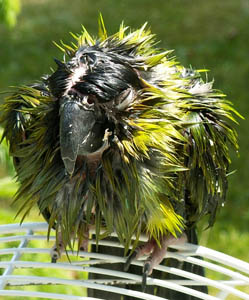
Dr. Laurie Hess is our resident exotics expert and contributes regularly on the Pet Health Network. For more from Dr. Hess, find her on Facebook!
Summer – time to go outside in the sunshine, breathe fresh air, picnic with friends, and take our pets outside to enjoy the weather, too. All sounds wonderful, until a pet becomes ill, injured, or escapes. How can we prevent summertime mishaps with our pets? Here are a few tips to help keep pets safe:
Beat the Heat
If you have a rabbit, guinea pig, chinchilla or other fuzzy creature that is not used to being outside in the heat, be sure to provide him or her with plenty of shade and lots of fresh water so that he or she doesn’t overheat in hot weather. Since that these animals originate genetically from cold climates where they have to keep warm, they were bred to have thick fur coats that retain heat, and they don’t have sweat glands like other mammals to release heat. So, it is essential that these pets not be left for long in direct sunlight or inside an unventilated car in summer; he or she will surely overheat and could easily die.
Safety First
If you plan to bring your exotic pet outside, be sure to keep him or her in a safe carrier or enclosure so that he or she doesn’t escape or isn’t attacked by wild animals. Remember, ferrets and birds can wriggle out of harnesses easily, and even slow moving reptiles can scurry away more quickly than you’d imagine and hide. These pets need to be kept safe in enclosures with tight fitting lids that can’t pop off when animals push against them. Most importantly, NEVER leave your exotic pet unattended outside, even in a carrier, no matter how safe you think he or she is, because wild predators who can break open carriers are lurking everywhere; all it takes is just a second for these animals to attack and make your pet a victim.
Prevent Unwanted Flight
Never, ever bring a flighted bird outside without having it in a well-ventilated carrier or clipping its wings. One gust of wind, and that bird could be gone. You never think it’s going to happen with your bird, but no one ever does. Every summer, one or two of my clients have their birds fly away unexpectedly, and they lose these birds forever. Wing trimming is one option to prevent your bird from flying if you are going to bring him or her outside. Different people have different philosophies about wing trimming. I support wing trimming, as every year, I see numerous birds not only fly away, but also fly into walls, windows, mirrors, ceiling fans, and even into pots of boiling water or into cups of hot coffee. Some of these birds are gravely injured. Wing trimming is like a haircut; it’s not painful and grows back in a few months. So, if you take your bird outside only in summer, to prevent flight temporarily, you might consider trimming the wings only during warm months when your bird might go outside.
Minimize Moisture
If your furry pet normally lives outside in a hutch or another enclosure, be sure to keep his or her litter and bedding dry and clean, especially during the heat of summer. Flies like to lay eggs that develop into larvae (maggots) in damp, soiled environments, and larvae love to live in moist folds of skin and small wounds on pets living outside. As larvae develop into adult flies, they produce toxins that can damage and kill healthy skin and the muscles and tissues that are beneath it, ultimately leading to potentially life-threatening systemic (whole-body) infections. So, leaving used litter or bedding around in your pet’s cage when it is warm outside for long periods may lead to serious infections and death. Daily litter changes and spot-cleaning to remove moist bedding from outdoor enclosures are essential to preventing fly-strike.
Chip to Travel
If you are planning to travel with your pet this summer, whether you are going by car, plane, or train, you may want to consider having your pet microchipped. Generally, microchipping is a simple, safe, one-time procedure performed in both birds and mammals, and it can be the only way to link a rescued pet to its owner so that the animal can be returned home. A microchip is a small implant about the size of a grain of rice that is safely placed under the skin either over the pet’s back (in a mammal) or in the breast muscle (in a bird). The microchip is labeled with a unique number that identifies a particular pet and can be read via a radiofrequency-controlled scanner most veterinarians and animal shelters have. If you’re not sure whether microchipping is right for your pet, be sure to talk to your veterinarian.
Summertime can be fun for both people and pets. Follow these basic warm weather tips, and both you and your exotic pet can enjoy this summer without a hitch!
If you have any questions or concerns, you should always visit or call your veterinarian – they are your best resource to ensure the health and well-being of your pets.
